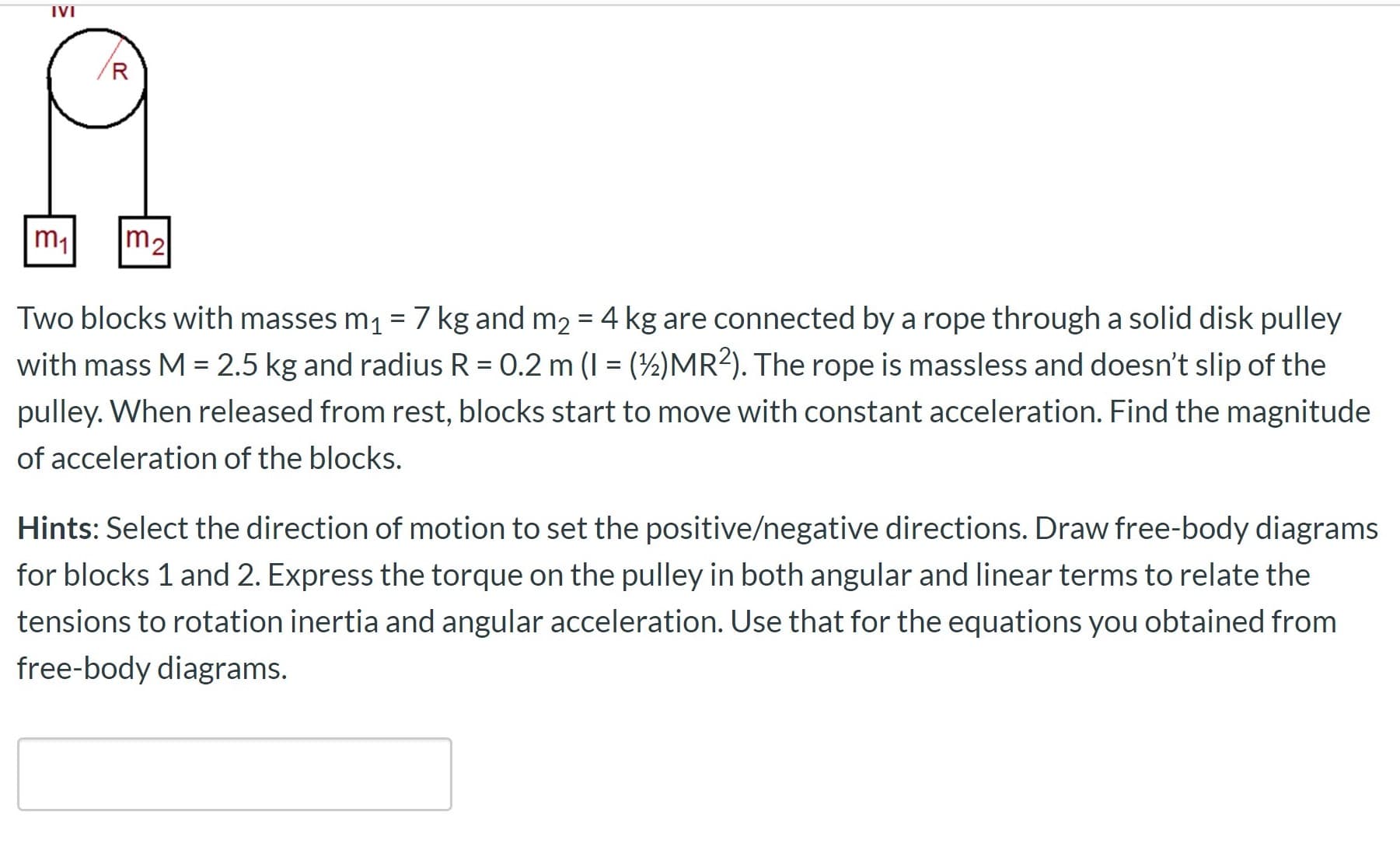IVI m1 m2 Two blocks with masses m1 =7 kg and m2 = 4 kg are connected by a rope through a solid disk pulley with mass M = 2.5 kg and radius R = 0.2 m (I = (½)MR?). The rope is massless and doesn't slip of the %3D pulley. When released from rest, blocks start to move with constant acceleration. Find the magnitude of acceleration of the blocks. Hints: Select the direction of motion to set the positive/negative directions. Draw free-body diagrams for blocks 1 and 2. Express the torque on the pulley in both angular and linear terms to relate the tensions to rotation inertia and angular acceleration. Use that for the equations you obtained from free-body diagrams.
IVI m1 m2 Two blocks with masses m1 =7 kg and m2 = 4 kg are connected by a rope through a solid disk pulley with mass M = 2.5 kg and radius R = 0.2 m (I = (½)MR?). The rope is massless and doesn't slip of the %3D pulley. When released from rest, blocks start to move with constant acceleration. Find the magnitude of acceleration of the blocks. Hints: Select the direction of motion to set the positive/negative directions. Draw free-body diagrams for blocks 1 and 2. Express the torque on the pulley in both angular and linear terms to relate the tensions to rotation inertia and angular acceleration. Use that for the equations you obtained from free-body diagrams.
College Physics
11th Edition
ISBN:9781305952300
Author:Raymond A. Serway, Chris Vuille
Publisher:Raymond A. Serway, Chris Vuille
Chapter7: Rotational Motion And Gravitation
Section: Chapter Questions
Problem 56AP: Keratinocytes are the most common cells in the skins outer layer. As these approximately circular...
Related questions
Question

Transcribed Image Text:IVI
m1
m2
Two blocks with masses m1 =7 kg and m2 = 4 kg are connected by a rope through a solid disk pulley
with mass M = 2.5 kg and radius R = 0.2 m (I = (½)MR?). The rope is massless and doesn't slip of the
%3D
pulley. When released from rest, blocks start to move with constant acceleration. Find the magnitude
of acceleration of the blocks.
Hints: Select the direction of motion to set the positive/negative directions. Draw free-body diagrams
for blocks 1 and 2. Express the torque on the pulley in both angular and linear terms to relate the
tensions to rotation inertia and angular acceleration. Use that for the equations you obtained from
free-body diagrams.
Expert Solution
This question has been solved!
Explore an expertly crafted, step-by-step solution for a thorough understanding of key concepts.
This is a popular solution!
Trending now
This is a popular solution!
Step by step
Solved in 2 steps with 2 images

Recommended textbooks for you

College Physics
Physics
ISBN:
9781305952300
Author:
Raymond A. Serway, Chris Vuille
Publisher:
Cengage Learning

Glencoe Physics: Principles and Problems, Student…
Physics
ISBN:
9780078807213
Author:
Paul W. Zitzewitz
Publisher:
Glencoe/McGraw-Hill

College Physics
Physics
ISBN:
9781305952300
Author:
Raymond A. Serway, Chris Vuille
Publisher:
Cengage Learning

Glencoe Physics: Principles and Problems, Student…
Physics
ISBN:
9780078807213
Author:
Paul W. Zitzewitz
Publisher:
Glencoe/McGraw-Hill